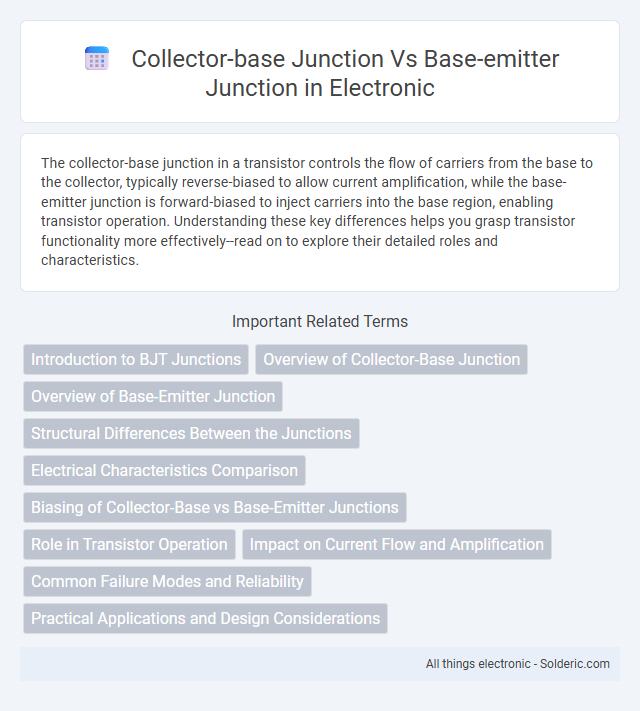The collector-base junction in a transistor controls the flow of carriers from the base to the collector, typically reverse-biased to allow current amplification, while the base-emitter junction is forward-biased to inject carriers into the base region, enabling transistor operation. Understanding these key differences helps you grasp transistor functionality more effectively--read on to explore their detailed roles and characteristics.
Comparison Table
| Aspect | Collector-Base Junction | Base-Emitter Junction |
|---|---|---|
| Type | Reverse biased in active mode | Forward biased in active mode |
| Function | Controls collector current flow | Controls base current, initiates transistor action |
| Biasing | Reverse biased (Collector positive relative to base in NPN) | Forward biased (Base positive relative to emitter in NPN) |
| Depletion Region Width | Wider depletion region | Narrower depletion region |
| Current Flow | Minority carrier controlled leakage current | Majority carrier injection current |
| Voltage Drop | Higher voltage drop | Approximately 0.7V in silicon BJTs |
| Role in Amplification | Collects carriers, enables output current | Injects carriers, enables input current |
Introduction to BJT Junctions
BJT junctions consist of the collector-base junction and the base-emitter junction, each serving distinct roles in transistor operation. The base-emitter junction is forward-biased to allow current flow, facilitating electron injection into the base region, while the collector-base junction is reverse-biased to collect these carriers, enabling amplification. Understanding the biasing conditions and electrical characteristics of these junctions is critical for designing and analyzing bipolar junction transistor circuits.
Overview of Collector-Base Junction
The collector-base junction in a bipolar junction transistor (BJT) is typically reverse-biased, forming a depletion region that controls the flow of charge carriers between the collector and base. This junction plays a crucial role in determining the transistor's amplification properties by influencing the collector current while minimizing the base current. Understanding the collector-base junction behavior helps optimize your transistor's efficiency and switching performance.
Overview of Base-Emitter Junction
The base-emitter junction in a bipolar junction transistor (BJT) acts as a forward-biased diode, allowing current to flow when sufficient voltage is applied, typically around 0.7 volts in silicon transistors. This junction controls the transistor's operation by regulating electron flow from the emitter to the base, enabling amplification of input signals. Unlike the reverse-biased collector-base junction, the base-emitter junction's forward bias is critical for transistor switching and amplification functions.
Structural Differences Between the Junctions
The collector-base junction in a bipolar junction transistor (BJT) is typically reverse-biased and has a wider depletion region compared to the forward-biased base-emitter junction, which has a narrow depletion region to facilitate efficient carrier injection. Structurally, the base-emitter junction features a heavily doped p-n interface that enables strong electron or hole injection, while the collector-base junction is lightly doped to support high voltage withstand capability and efficient charge collection. These doping and structural variations influence the junction capacitance, breakdown voltage, and the transistor's overall switching and amplification characteristics.
Electrical Characteristics Comparison
The collector-base junction typically operates under reverse bias with a higher breakdown voltage, allowing it to sustain greater voltage without conduction, while the base-emitter junction is forward biased during normal operation, exhibiting a lower turn-on voltage around 0.7V for silicon transistors. The base-emitter junction controls the transistor's conduction and exhibits a lower current compared to the collector-base junction, which handles the main current flow through the device. Leakage currents are minimal in the collector-base junction under reverse bias, whereas the base-emitter junction shows noticeable forward current for the transistor to amplify signals effectively.
Biasing of Collector-Base vs Base-Emitter Junctions
The base-emitter junction in a bipolar junction transistor (BJT) is forward biased to allow current flow from the emitter to the base, facilitating transistor operation. The collector-base junction is reverse biased to control the flow of carriers, enabling the transistor to amplify current. Proper biasing of these junctions maintains the transistor in its active region, essential for optimal performance in amplification applications.
Role in Transistor Operation
The collector-base junction controls the flow of electrons by acting as a reverse-biased barrier, which helps regulate the transistor's amplification capability. The base-emitter junction is forward-biased, enabling electron injection from the emitter into the base, initiating current flow through the transistor. This interplay between the two junctions is critical for the transistor's ability to switch and amplify electrical signals.
Impact on Current Flow and Amplification
The collector-base junction, typically reverse-biased, controls the width of the depletion region and prevents current flow, allowing the transistor to operate in active mode for amplification. The base-emitter junction is forward-biased, enabling injection of charge carriers into the base that facilitate current flow from emitter to collector. This difference in biasing creates a small base current that controls a much larger collector current, making the transistor an effective current amplifier.
Common Failure Modes and Reliability
Collector-base junctions commonly face leakage current issues and breakdown due to high voltage stress, which can degrade transistor performance and reliability. Base-emitter junctions are prone to junction shunting and increased forward voltage drop caused by thermal runaway and excessive current flow, leading to device failure. Both junctions require careful thermal and electrical management to ensure long-term reliability in semiconductor devices.
Practical Applications and Design Considerations
The collector-base junction in transistors operates predominantly as a reverse-biased diode, crucial for controlling the transistor's amplification and switching performance in circuits such as amplifiers and digital logic devices. The base-emitter junction acts as a forward-biased diode, facilitating the injection of charge carriers necessary for transistor activation and stable biasing, directly influencing input impedance and gain characteristics. Design considerations emphasize ensuring proper biasing of the base-emitter junction to maintain transistor operation within the active region, while managing the collector-base junction's breakdown voltage and leakage current to enhance reliability and efficiency in high-frequency and high-power applications.
Collector-base junction vs Base-emitter junction Infographic

 solderic.com
solderic.com